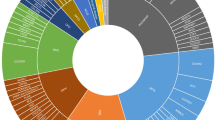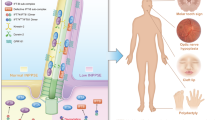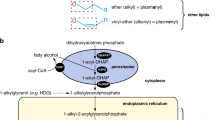Abstract
We report a null mutation in the human ciliary neurotrophic factor gene (CNTF). The mutated allele shows a G to A transition producing a new splice acceptor site and the resulting mRNA species codes for an aberrant protein. Analysis of tissue samples and transfection of CNTF minigenes into cultured cells demonstrates that the mutated allele expresses only the mutated mRNA species. In 391 Japanese people tested, 61.9% were normal homozygotes, 35.8% heterozygotes and 2.3% mutant homozygotes. The distribution of the three genotypes is similar in healthy and neurological disease subjects, indicating that human CNTF deficiency is not causally related to neurological diseases.
This is a preview of subscription content, access via your institution
Access options
Subscribe to this journal
Receive 12 print issues and online access
$209.00 per year
only $17.42 per issue
Buy this article
- Purchase on Springer Link
- Instant access to full article PDF
Prices may be subject to local taxes which are calculated during checkout
Similar content being viewed by others
References
Adler, R., Landa, K.B., Manthorpe, M. & Varon, S. Cholinergic neuronotrophic factors: intraocular distribution of trophic activity for ciliary neurons. Science 204, 1434–1436 (1979).
Barbin, G., Manthorpe, M. & Varan, S. Purification of the chick eye ciliary neuronotrophic factor. J. Neurochem 43, 1468–1478 (1984).
Stöckli, K.A. et al. Molecular cloning, expression and regional distribution of rat ciliary neurotrophic factor. Nature 342, 920–923 (1989).
Lin, L.-F.H. et al. Purification, cloning, and expression of ciliary neurotrophic factor (CNTF). Science 246, 1023–1025 (1989).
Blottner, D., Brüggemann, W. & Unsicker, K. Ciliary neurotrophic factor supports target-deprived preganglionic sympathetic spinal cord neurons. Neurosci. Lett. 105, 316–320 (1989).
Sendtner, M., Kreutzberg, G.W. & Thoenen, H. Ciliary neurotrophic factor prevents the degeneration of motor neurons after axotomy. Nature 345, 440–441 (1990).
Arakawa, Y., Sendtner, M. & Thoenen, H. Survival effect of ciliary neurotrophic factor (CNTF) on chick embryonic motoneurons in culture: comparison with other neurotrophic factors and cytokines. J. Neuroscience 10, 3507–3515 (1990).
Oppenheim, R.W., Prevette, D., Qin-Wei, Y., Collins, F. & MacDonald, J. Control of embryonic motoneuron survival in vivo by ciliary neurotrophic factor. Science 251, 1616–1618 (1991).
Martinou, J.-C., Martinou, I. & Kato, A.C. Cholinergic differentiation factor (CDF/LIF) promotes survival of isolated rat embryonic motoneurons in vitro. Neuron 8, 737–744 (1992).
Sendtner, M. et al. Ciliary neurotrophic factor prevents degeneration of motor neurons in mouse mutant progressive motor neuronopathy. Nature 358, 502–504 (1992).
Ip, N.Y. et al. Ciliary neurotrophic factor enhances neuronal survival in embryonic rat hippocampal cultures. J. Neuroscience 11, 3124–3134 (1991).
Hagg, T., Quon, D., Higaki, J. & Varon, S. Ciliary neurotrophic factor prevents neuronal degeneration and promotes low affinity NGF receptor expression in the adult rat CNS. Neuron 8, 145–158 (1992).
Saadat, S., Sendtner, M. & Rohrer, H. Ciliary neurotrophic factor induces Cholinergic differentiation of rat sympathetic neurons in culture. J. Cell Biol. 108, 1807–1816 (1989).
Hughes, S.M., Lillien, L.E., Raff, M.C., Rohrer, H. & Sendtner, M. Ciliary neurotrophic factor induces type-2 astrocyte differentiation in culture. Nature 335, 70–73 (1988).
Lillien, L.E., Sendtner, M., Rohrer, H., Hughes, S.M. & Raff, M.C. Type-2 astrocyte development in rat brain cultures is initiated by a CNTF-like protein produced by type-1 astrocytes. Neuron 1, 485–494 (1988).
Rende, M. et al. Immunolocalization of ciliary neuronotrophic factor in adult rat sciatic nerve. Glia 5, 25–32 (1992).
Dobrea, G.M., Unnerstall, J.R. & Rao, M.S. The expression of CNTF message and immunoreactivity in the central and peripheral nervous system of the rat. Dev. Brain Res. 66, 209–219 (1992).
Friedman, B. et al. Regulation of ciliary neurotrophic factor expression in myelin-related Schwann cells in vivo. Neuron 9, 295–305 (1992).
Leung, D.W. et al. Cloning, expression during development, and evidence for release of a trophic factor for ciliary ganglion neurons. Neuron 8, 1045–1053 (1992).
Stöckli, K.A. et al. Regional distribution, developmental changes, and cellular localization of CNTF-mRNA and protein in the rat brain. J. Cell Biol. 115, 447–459 (1991).
Davis, S. et al. The receptor for ciliary neurotrophic factor. Science 253, 59–63 (1991).
Ip, N.Y. et al. The α component of the CNTF receptor is required for signaling and defines potential CNTF targets in the adult and during development. Neuron 10, 89–102 (1993).
Masu, Y. et al. Disruption of the CNTF gene results in motor neuron degeneration. Nature 365, 27–32 (1993).
Masiakowski, P. et al. Recombinant human and rat ciliary neurotrophic factors. J. Neurochem. 57, 1003–1012 (1991).
Lam, A. et al. Sequence and structural organization of the human gene encoding ciliary neurotrophic factor. Gene 102, 271–276 (1991).
Negro, A. et al. Cloning and expression of human ciliary neurotrophic factor. Eur. J. Biochem. 201, 289–294 (1991).
McDonald, J.R., Ko, C., Mismer, D., Smith, D.J. & Collins, F. Expression and characterization of recombinant human ciliary neurotrophic factor from Escherichia coli. Biochim. Biophys. Acta 1090, 70–80 (1991).
Kim, D.W., Uetsuki, T., Kaziro, Y., Yamaguchi, N. & Sugano, S. Use of the human elongation factor 1 α promoter as a versatile and efficient expression system. Gene 91, 217–223 (1990).
Bazan, J.F. Neuropoietic cytokines in the hematopoietic fold. Neuron 7, 197–208 (1991).
Ip, N.Y. et al. CNTF and LIF act on neuronal Cells via shared signaling pathways that involve the IL-6 signal transducing receptor component gp130. Cell 69, 1121–1132 (1992).
Taga, T. et al. Functional inhibition of hematopoietic and neurotrophic cytokines by blocking the interleukin 6 signal transducer gp130. Proc. natn. Acad. Sci. U.S.A. 89, 10998–11001 (1992).
Rao, M.S. & Landis, S.C. Cell interactions that determine sympathetic neuron transmitter phenotype and the neurokines that mediate them. J. Neurobiol. 24, 215–232 (1993).
Sendtner, M., Stöckli, K.A. & Thoenen, H. Synthesis and localization of ciliary neurotrophic factor in the sciatic nerve of the adult rat after lesion and during regeneration. J. Cell Biol. 265, 12757–12760 (1992).
McKhann, G. et al. Clinical diagnosis of Alzheimer's disease: Report of the NINCDS-ADRDA Work Group under the auspices of Department of Health and Human Services Task Force on Alzheimer's Disease. Neurology 34, 939–944 (1984).
Deguchi, T., Mashimo, M. & Suzuki, T. Correlation between acetylator phenotypes and genotypes of polymorphic arylamine N-acetyltransferase in human liver. J. biol. Chem. 265, 12757–12760 (1990).
Sambrook, J., Fritsch, E.F. & Maniatis, T. Molecular Cloning: A Laboratory Manual 2nd edn, 7.71–7.78, (Cold Spring Harbor Laboratory Press, New York, 1989).
Smith, D.B. & Johnson, K.S. Single-step purification of polypeptides expressed in Escherichia coli as fusions with glutathione S-transferase. Gene 67, 31–40 (1988).
Nicoloso, M., Qu, L.H. & Bachellerie, J.-P. Titration of variant DNA sequences differing by a single point-mutation by selective dot-blot hybridization with synthetic oligonucleotides. Biochem. Biophys. Res. Commun. 159, 1233–1241 (1989).
Author information
Authors and Affiliations
Rights and permissions
About this article
Cite this article
Takahashi, R., Yokoji, H., Misawa, H. et al. A null mutation in the human CNTF gene is not causally related to neurological diseases. Nat Genet 7, 79–84 (1994). https://doi.org/10.1038/ng0594-79
Received:
Accepted:
Issue Date:
DOI: https://doi.org/10.1038/ng0594-79
This article is cited by
-
Ciliary neurotrophic factor is increased in the plasma of patients with obesity and its levels correlate with diabetes and inflammation indices
Scientific Reports (2022)
-
Interleukin-11 signaling underlies fibrosis, parenchymal dysfunction, and chronic inflammation of the airway
Experimental & Molecular Medicine (2020)
-
Ciliary neurotrophic factor stimulates cardioprotection and the proliferative activity in the adult zebrafish heart
npj Regenerative Medicine (2019)
-
Effect of human very low-density lipoproteins on cardiotrophin-like cytokine factor 1 (CLCF1) activity
Scientific Reports (2018)
-
Neurotrophic factor control of satiety and body weight
Nature Reviews Neuroscience (2016)



